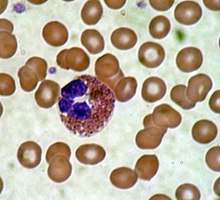Eosinophil
Eosinophil granulocytes - also called eosinophils or "Eos" for short - belong to the leukocytes. They make up about 1-5 % of the leukocytes in the differential blood count and are involved in the cellular immune defense. They get their name from the dye eosin, with which they can be stained. Eos (ancient Greek) means dawn. Physiologically, the eosinophils are increased in the lymphocytic-eosinophilic healing phase.
In their interior, eosinophilic granulocytes contain vesicles, also called granules, which contain basic proteins, e.g. the Major Basic Protein, lysosomal hydrolytic enzymes and peroxidase. The contents of the granules can be released into the environment by exocytosis. Triggers for this include antibodies of the IgE class. Furthermore, they are capable of chemotaxis, i.e. they can move amoeboid towards an attracting substance (attractant). In addition to the toxic effect of their granules, eosinophils also have the ability of phagocytosis.
Eosinophils play an important role in parasite defence. As soon as the surface of the parasite is occupied by IgE, eosinophils bind to it. This serves as a stimulus for the release of the toxic contents of the granules onto the surface of the parasite. At the same time, in addition to damaging the parasite, the exocytosed proteins serve as attractants for other eosinophils so that the defense can be strengthened.
However, eosinophils can also play a damaging role for the organism itself. In bronchial asthma, for example, the lung epithelium is damaged by the constituents of the eosinophils. In COPD, different treatments are possible depending on the amount of eosinophils in the blood. Rare diseases triggered by eosinophils include eosinophil fasciitis and hypereosinophil syndrome, as well as eosinophil esophagitis. The number is also increased in allergies, so that the so-called eosinophilia is an important indicator of the presence of allergy. A reduction in the number of eosinophils is called eosinopenia.
In cats and dogs, immigration of eosinophils into the skin may occur, especially in association with allergies (feline eosinophilic granuloma complex, canine eosinophilic facial furunculosis). The migration of eosinophils into the intestinal wall (feline eosinophilic enteritis, feline gastrointestinal eosinophilic sclerosing fibroplasia) or bronchial wall (feline asthma) also occurs in animals.

eosinophil granulocyte
See also
- neutrophil
- basophilic granulocyte
- eosinophilic plaque
Search within the encyclopedia